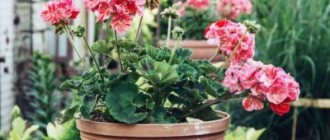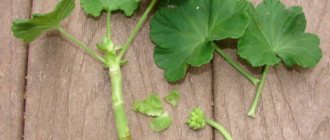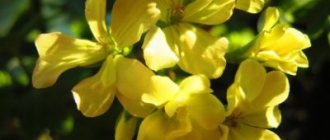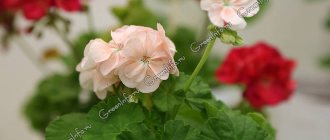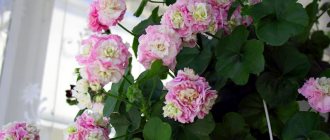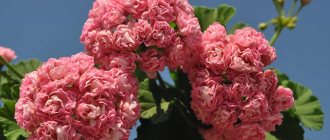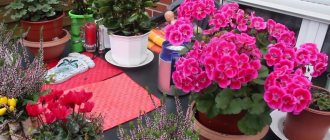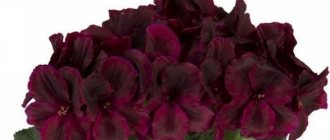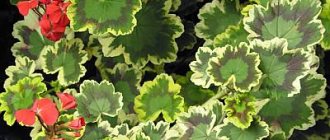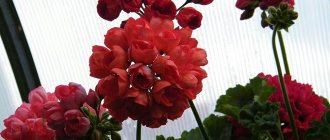How to properly care?
Pelargonium Norland - grows and blooms well in a pot on the windowsill, but in order for the flowering to be abundant, you will have to take care of it. The rules are not complicated, but in order for the plant to be strong and healthy, it is advisable to follow them unquestioningly.
Watering
In summer, watering should be plentiful and very frequent, since during hot periods pelargonium flower buds may fall off due to lack of moisture. But at the same time, you should not over-water the plant, and if moisture has accumulated in the pan after watering, it must be drained - this will prevent rotting of the roots.
When watering, use only settled, soft water that does not contain limescale. There is no need to spray pelargonium during flowering; it can not only lose its decorative effect, but also rot.
Top dressing
For Norland pelargonium, only mineral fertilizers are applicable. Feeding the plant is strictly prohibited. But this applies not only to this variety; all geraniums have a negative attitude towards organic fertilizers. It is better to apply mineral complexes during the period of active growing season and rapid flowering. Feeding is done once every 2 weeks in summer. As for the winter period, there is no need to add additional food.
Transfer
- Pelargonium does not like frequent transplants, so it is obviously better not to touch it until the pot becomes cramped. This is very easy to determine - the roots of the plant will stick out from the drainage holes.
- When replanting, you should not take a large pot - pelargonium will stop blooming; each new pot should be 1.5 cm larger than the previous one. Flowering begins only after the earthen ball is completely filled with roots.
- The soil in the pot must be completely replaced; to do this, carefully free the roots from the old soil, being careful not to damage them, then transfer the pelargonium to the new soil. After replanting, fertilizing is not carried out for a month and a half, since the new soil is already nutritious.
- You should not touch the plant during the active growing season; you need to wait until the pelargonium fades and goes into a dormant state. It will also tolerate transplantation well in early spring.
Attention! Many gardeners claim that after pelargonium grows to 30 cm in height, it is no longer necessary to replant it
Trimming
Pelargonium Norland needs high-quality and regular pruning. This is the only way to form a beautiful, compact and dense bush with large double flowers.
This process is carried out in the spring, the shoots are shortened by a third. Pruning allows you to stimulate the flower to form new shoots and bloom luxuriantly. If you do not pinch and trim, the geranium will stretch tall, the lower leaves will fall off the stems and you may not even get flowers. In the fall, dry and weak shoots are removed from the bush so that during the dormant period the pelargonium gains strength for new flowering.
Video tutorial on pruning pelargonium:
Pink terry pelargonium in varietal diversity
Judging by the number of varieties presented, one can understand that this color is not uncommon for pelargonium. I will try to show the varietal diversity of pink terry geraniums.
Granny Barter - pale pink flowers. The buds are almost white. The petals have a rich shade towards the center of the flower. Large inflorescences look like bows. The bush is small, usually standard, like all other geraniums. Does not grow when formed using trimmings.
Norrland - lush pink inflorescences of densely double buds “fly up” above the stems on long strong shoots. The foliage is green, decorative. The flowers look more like blossoming peonies than roses, as the buds are very lush.
Passat – soft pink pelargonium with double flowers. The corrugated petals of the corolla complement the beauty. This makes the flower look like fluffy pompoms.
Shelk Moira – pink-orange geranium, salmon color. The variety amazes with the tenderness of the inflorescences. They can shimmer depending on the lighting. Some petals may be very rich, others paler. This is a Russian variety with dense inflorescences. The petals of the corolla are wavy.
Brookside Fantasy – This double pelargonium bushes are compact and deep green. Blooms abundantly, with pink flowers.
Highfield's Fancy - zonal pink - is another compact variety that does not require constant shaping pruning. The flowers are large and dense. They are deep pink with a subtle tint. In the center the bud is white or cream.
Highfield's Prima Donna is a soft pink variety. The foliage is velvety, dark green. It blooms with crimson buds with numerous petals. They have a small white eye. It may be light pink.
Description of varieties
Lara Harmony
Pelargonium Lara Harmony is one of the varieties that belongs to the zonal group (the name “zonal” comes from the pronounced brown zone on the green leaf of pelargonium).
The flowers are double, lush, and when fully opened their rich pink color resembles a rose.
Lara Delight
This is a beautiful hybrid variety called Zonartik. A very powerful bush, with large, not very double flowers of bright cyclamen color or shades of fuchsia with a small bright white core. Also belongs to the group of zonal ones.
Lara Marjorie
It is a zonartik with a compact lush holly bush. The flowers are large, double, white-yellow, with pink splashes on the upper petals. A distinctive feature is a very long powerful peduncle that reaches 30 cm.
Lara Alf
Pelargonium zonartik with bright scarlet inflorescences and a pronounced core. Blooms very easily. The flowers are large, quite dense, held on a slender but strong peduncle. The bush is compact, low.
Lara Rita
Lara Rita is a flower of moderation in everything. This is one of the hybrids with a low bush. On relatively short peduncles there are dense inflorescences. The flowers are a delicate salmon color, may be brighter, with semi-double petals of medium density.
Lara Largo
The plant has a fairly powerful and dense inflorescence. This pelargonium is distinguished by a vertically elongated bush with very large pink-orange double flowers. The leaves are glossy, almost without velvet, rich green, large and juicy, without a pronounced zone. The stems are dense and smooth.
Lara Enwoy
This variety is not very common. The bush is compact and does not stretch upward. Thick stems grow almost horizontally. The flowers are large, double, white-salmon in color, the petals resemble feathers.
Lara Gem
Lara Gem is a strong, beautiful plant that requires fresh air and space. Medium-sized pelargonium with a high peduncle, with a beautiful lush inflorescence. The flowers are double, pink, with a light spot on the upper petals, the leaves are bright green and succulent.
Lara Genie
Medium sized plant bush. On a tall, strong peduncle there is a delicate umbrella of pale pink color, similar to an orchid flower. The leaves are lacy and bright.
Lara Susanne
A very passionate and expressive flower in appearance. This plant can be easily recognized by the pronounced contrast of bright warm pink shades and rich dark green leaves. It blooms magnificently and abundantly, while being quite unpretentious.
Lara Mandarin
The inflorescence of this hybrid, when fully opened, resembles a round, juicy tangerine. The bright and at the same time delicate peach color smoothly flows into the yellow core. The inflorescence is dense and lasts a long time on a high stalk. The serrated leaves have a lush green color.
Lara Prince
The plant is quite compact, with dark green leaves and a pronounced brown zone. But on this seemingly small bush, relatively large and generous inflorescences bloom. The color of the petals ranges from pale lilac to lilac-pink shades.
There are many other varieties of Lara Pelargonium that are not covered in this article, such as Unicorn Zonartic Rose, Rachel, Orion, Brookside Fiesta, Peter, East Sussex, Lucy Gunnet, Alex Kidson, Bold Limelight and many others. They are all beautiful, and each variety is unusual in its own way.
It's no surprise that many gardeners are in love with these indoor flowers.
See below for fragrant pelargonium Lara Jester.
Varieties of indoor plants with names and what they look like
Today there are many varieties of this pelargonium. Each of them has distinctive features.
Today there are many color variations of pelargoniums known
Angel Viola
This culture is a compact plant, which is characterized by long and lush flowering. All summer the bushes can be decorated with pink flowers. A characteristic feature is the contrasting crimson spot on the petals.
Angeleyes Orange
This plant has deep orange petals. The appearance of the bush is also improved by small leaves that have an openwork structure.
For reference! Pelargonium Orange is perfect for hanging structures.
Michael
This variety is characterized by small bushes and flowers with many petals. They have a cherry center and a white border.
How to properly care?
Temperature
In summer, the flower prefers to be in a temperate warm climate. The temperature will be 17-23 degrees Celsius. Planting outside is done only after the danger of frost returning has passed. At temperatures of 12 degrees and below, flowering stops. Heat is also unacceptable for the plant, especially indoors. You can tell that a flower is cold by its reddened leaves.
ATTENTION! With the arrival of autumn, it is better to gradually lower the temperature and water the flower abundantly. Growth should not be active, otherwise the plant will begin to stretch and become exhausted in poor light.
Winter period
In winter, pelargonium zonartik is kept in a greenhouse or glassed-in balcony. The temperature should not fall below +6 degrees at night and +12+15 degrees during the day. On sunny days, open windows for ventilation to avoid overheating. In winter, excellent air circulation is important for the flower. Do not place pots close to each other. If necessary, thin out the crowns. This will prevent the development of fungal diseases.
Water in winter infrequently and sparingly. Do this from pallets, carefully measuring the amount of water and time for the next watering throughout the entire container. Moreover, the top of the soil should be dry. Overwintering of pelargonium zonartik can take place in other ways:
- This method involves saving plants as cuttings that have already taken root. In this case, the mother plant is thrown away. This method is used for summer growing pelargonium outdoors.
- This method is also used for keeping flowers outdoors. Before frost, remove the plant from the soil with its roots and shake off the excess soil. Cut the flower and wrap it in paper. Place in a cool basement. Choose a room with excellent ventilation and high humidity. Otherwise, the plant may dry out.
These two methods can be combined: first take cuttings, and then send the mother plant to a cool room for the winter. Wintering occurs at the warmest time and lasts 3 months (November-February). At the end of January and beginning of February, when daylight hours begin to increase, pelargonium begins to gradually awaken.
Watering
REFERENCE! Pelargonium zonartik is a moisture-resistant plant, but at the same time it is susceptible to fungal diseases. So it’s better to underwater it than to overwater it.
In summer, watering is carried out as the top layer of soil dries. In this case, the plant should be in a warm and sunny place. In winter, limit watering, but do not allow the soil to dry out completely. Excessive moisture can be recognized by drooping and limp leaves. In addition, symptoms of gray rot will begin to appear.
In severe cases, the stem rots, which ultimately leads to the death of the flower. Another symptom of excess moisture is the “sores” that form on the underside of the leaves. When the earthen clod dries out, flowering stops, the leaves turn yellow, and the edges die. For irrigation, only settled, warm and soft water is used. Air humidity is not important for pelargonium zonartik.
These flowers do not need spraying. Excessive humidity and stagnant air promote the development of fungus.
Feeding
Fertilizing should be introduced with each watering, while reducing the dosage. For example, if moistening is carried out daily, then the weekly fertilizer rate should be divided by 7-10. Apply the resulting dosage to each watering. If the lump of earth has dried out between irrigations, moisten it with clean water.
During the winter rest period, fertilizing should not be applied if the temperature is low and the plant is completely resting. When slight growth of the flower is visible, the introduction of fertilizer should be restored to ¼ dosage. After rooting the cuttings, fertilizer with a high concentration of nitrogen is used.
ATTENTION! To feed young plants that are too early to bloom, use a complex universal fertilizer. Before flowering, 2-3 months, you will need to use a fertilizer with a high concentration of potassium.
If there are signs of chlorosis, treat with magnesium sulfate and iron chelan.
Growing pelargoniums
Cultivation of these pelargoniums in a perennial culture is possible in climatic conditions where the sum of positive temperatures during the growing season is at least 3500-4000°C, the thermometer does not fall below zero, and below +10°C - only for a very short time. The frost resistance of the plant is very weak, even at prolonged positive temperatures the plant begins to die quietly, and if the thermometer drops below zero, then you can simply say goodbye to the geranium. On the one hand, the plant is drought-resistant, but during prolonged drought it begins to lose leaves and stops growing. It also does not tolerate excess moisture in the soil and is severely affected by root rot.
The culture is light-loving; with a lack of light, it smells less and less, that is, essential oil practically ceases to be produced. The main requirement for soils is a neutral or alkaline reaction of the environment (pH 6-7.5), light mechanical composition, high fertility. Accordingly, soil mixtures that contain a sufficient amount of sand and peat are suitable. If the reaction is acidic, the soil mixture must be neutralized with lime.
It is advisable to supplement the mother plants with additional light and feed them from February so that full-fledged shoots grow on them, which will become cuttings. You can take cuttings from the end of March to the beginning of April. Before rooting, the cuttings are treated with a growth stimulator, some of the available ones include Kornevin and Ukorenit. A nutrient mixture consisting of turf soil, well-rotted compost or peat and clean river sand (1:1:1) is poured into the bottom of the pot. On top is washed sand in a layer of 4-5 cm. The cuttings are planted to a depth of 3-4 cm, providing a feeding area of 5x5 cm. Cover the top with a jar. And, given that if you have a summer house, a cutting plant is always needed, you can adapt an old aquarium or something similar for it. Optimal rooting conditions: temperature +20+25°C and relative humidity 85-90%. Cuttings take root after 30-35 days.
Rooted plants are planted in boxes or pots. In boxes, they can be combined with beautiful flowering plants and placed on balconies or patios. Pots in the country can be buried in a fragrant mixborder or under the windows of the house on the sunny side. A pleasant aroma, especially on a hot day, is guaranteed.
Care includes mandatory fertilizing with nitrogen fertilizers and timely watering. They should be plentiful, but not frequent.
You will have to keep the queen cells at home on the windowsill.
Features of plant flowering
Anita is a variety of pelargonium characterized by lush flowering. With proper care it can last quite a long time. During the season, several inflorescences appear on one flower, which both replace each other and bloom simultaneously.
Pelargonium Anita
Period of activity and rest
The period of activity begins with the onset of spring, when the formation of buds begins. The flowering season is long, several months. Most often, Anita pelargonium blooms throughout the summer months until mid-autumn, when the temperature drops and daylight hours are noticeably reduced. The variety requires mandatory rest at low temperatures, reduced watering and no fertilizers. During the winter months, Anita needs to be provided with all these conditions. If she does not rest and accumulate strength for the new season, flowering may not occur.
Types and shape of flowers
The shape of the flowers is round, the inner petals are always tightly closed, so the middle is always closed. The color is very delicate, thin, pinkish. Externally, the flowers of this pelargonium are very reminiscent of rose flowers.
Popular varieties
Thanks to long-term selection work, which has not yet stopped, the gardener can choose different pelargoniums. They differ in size, color and shape of inflorescences.
"Yu jig"
Common standard option. The stem is straight, the plant reaches medium height. The inflorescences are dense, double, and have a delicate coral hue. Pelargonium Yu Jig will delight any lover of indoor plants with its flowering.
Lake
An unpretentious variety, which is distinguished by spherical inflorescences of salmon color, the edges of the petals are slightly lighter. The leaves are rounded with a brown zone. Pelargonium reaches medium size.
Rafaella F1
A compact plant whose height does not exceed 30 cm. Adapted for growing in flower beds, balconies and in rooms.
Double flowers can be colored milky, peach, orange or scarlet.
Important! With proper care it blooms throughout the year. The variety is quite new and therefore difficult to find on sale. Pelargonium is adapted to different conditions, so it tolerates heat and cold.
Pelargonium is adapted to different conditions, so it tolerates heat and cold.
The variety is quite new and therefore difficult to find on sale. Pelargonium is adapted to different conditions, so it tolerates heat and cold.
Bold Gold
Suitable for growing in open ground and at home. It has abundant flowering, the leaves are light green with a brown ring in the center. The color of the inflorescences includes all shades of pink and red.
Other varieties
Pelargonium Lara Harmony has double flowers of a lilac hue. Large umbrella inflorescences appear from the beginning of spring until the end of autumn. Differs in miniature size. Lara Harmony is a pelargonium with flowers that resemble a rose.
The Minx variety is also characterized by small growth and bright scarlet inflorescences. They stand out especially against the background of dark foliage.
Yu Gamayun pelargonium with unique lilac flowers
Each variety has its own characteristics. You can collect a unique collection of plants, which will differ in inflorescence color and size. For example, pelargonium Silk Swan is compact, has a thick stem, dense leaves, and white flowers.
For reference! It is advisable to compare all the names of the varieties and use only those in Latin. In stores, sellers cannot always correctly identify the type of plant.
Pelargonium Lara Delight is medium in size and the inflorescences are fuchsia with a white center. This variety is not as lush as the others, but it has a beautiful color.
- Pelargonium Lara Delight will appeal to lovers of everything bright and attractive. You can look for varieties with calmer colors. Large plants can become a decoration of the garden.
- Yu Disko is a rare and not so popular pelargonium. Her inflorescences are pale pink and they are collected in small umbrellas. Tall peduncles make spherical flowers noticeable among other plants.
- Pelargonium Yu Princess has a similar color, but the inflorescences are rosebud and with small light shades of pink. Over time, the petals begin to curl into a tube, which gives the plant an unusual appearance.
- Yu Kathak is a pelargonium with an unusual leaf color. There is a brown border on a yellow background. The inflorescences themselves are double and bright red. The variety is large and easily tolerates pruning.
Pelargonium Yu Lilac Mist features pale purple flowers
For reference! In stores you can often find plants of different varieties, but sellers usually do not separate them. You can buy geraniums in different shades in this mix.
How to care at home
If you follow all the rules of care, the flower will not cause problems or troubles.
Lighting
Pelargonium Norland needs good lighting, however, it does not tolerate direct sunlight. Therefore, sparse shade or artificially created shading at midday is best suited for it.
Note that under the influence of the scorching sun the plant loses its decorative properties and may categorically refuse to bloom.
However, if you grow Norland pelargonium in conditions of severe lack of light, the plant will form lush greenery, but may refuse to bloom.
Temperature
This plant is not thermophilic, and moderate air temperatures suit Norland best. So, the average daily temperature in summer should be +18-25 degrees, and in winter - +10-12 degrees.
Note that this flower feels very good outdoors, so in the summer, if possible, it is recommended to take the pot to the balcony, terrace, veranda, or garden. When ventilating the plant, you should not create strong drafts; they have a very negative effect on flowering.
Watering
The soil must be constantly moist, so it is necessary to water regularly. Their frequency will depend on the season: in the hot summer, the flower is watered at least 3 times a week, but with the arrival of winter, the frequency of watering should be reduced to 1-2 times.
To prevent excess water from accumulating in the ground, it is loosened after each watering. The water must be of high quality and clean; tap liquid must not be used. First, it is left to stand for almost 5-6 hours in a wide and shallow container. Stir it from time to time to remove all the chlorine. The water temperature should be identical to room temperature.
Pelargonium Norland does not need spraying. Moreover, drops of moisture getting on the leaves and buds can lead to the plant losing its decorative properties and even to disease and rotting.
Feeding
For Norland pelargonium, only mineral fertilizers are applicable. Feeding the plant is strictly prohibited. But this applies not only to this variety; all geraniums have a negative attitude towards organic fertilizers.
It is better to apply mineral complexes during the period of active growing season and rapid flowering. Feeding is done once every 2 weeks in summer. As for the winter period, there is no need to add additional food.
Trimming
Pelargonium Norland needs high-quality and regular pruning. This is the only way to form a beautiful, compact and dense bush with large double flowers.
This process is carried out in the spring, the shoots are shortened by a third. Pruning allows you to stimulate the flower to form new shoots and bloom luxuriantly. If you do not pinch and trim, the geranium will stretch tall, the lower leaves will fall off the stems and you may not even get flowers.
In the fall, dry and weak shoots are removed from the bush so that during the dormant period the pelargonium gains strength for new flowering.
Transfer
- Pelargonium does not like frequent transplants, so it is obviously better not to touch it until the pot becomes cramped. This is very easy to determine - the roots of the plant will stick out from the drainage holes.
- When replanting, you should not take a large pot - pelargonium will stop blooming; each new pot should be 1.5 cm larger than the previous one. Flowering begins only after the earthen ball is completely filled with roots.
- The soil in the pot must be completely replaced; to do this, carefully free the roots from the old soil, being careful not to damage them, then transfer the pelargonium to the new soil. After replanting, fertilizing is not carried out for a month and a half, since the new soil is already nutritious.
- You should not touch the plant during the active growing season; you need to wait until the pelargonium fades and goes into a dormant state. It will also tolerate transplantation well in early spring.
Transplanting seedlings
When several leaves appear on the shoots of geranium sprouts, it needs to be plucked, that is, planted. The seedlings are transplanted into small pots. When picking, it would not hurt to use clay pots, as this is the most correct solution, because they retain moisture much longer and protect plant roots from overheating. When planting, it is advisable to apply long-term fertilizer, and also do not forget to constantly loosen the soil. If there is no longer a threat of frost, then geraniums can be planted outside.
If the geranium is outdoors, if the air temperature reaches below +10°C, it is necessary to cover it with film or move it indoors. In hot weather, geraniums should be watered no more than once a day, and in average temperatures, they need watering once every couple of days. When watering, you need to make sure that water does not get on the plant and its leaves. Geranium is afraid of drafts, so it is not advisable to spray the flower with the doors open, as it may freeze and die. Twice a month it is necessary to feed the soil with any flower fertilizers that can be found in flower shops.
Faded inflorescences will need to be removed, but only from those varieties of geranium that need it and if this variety does not shed them itself. You need to pinch the flower so that its stem does not stretch upward. This can help form a small crown. This should be done only when the plant has reached a height of 10-12 cm.
At the moment, geranium is in great demand, as it has a number of advantages. This light-loving plant will appeal to many people, as it has a bright color, and its splendor is competitive with other plants. Not everyone may like the specific smell of pelargonium, but knowing its beneficial properties, many change their attitude towards this flower. Those rooms in which pelargonium is located are endowed with their own positive energy. In such premises there are practically no flies, mosquitoes and plant pests.
Geranium is easy to care for. It needs constant watering, but in its absence for no more than three weeks it will still feel great. With such a long break, it is advisable that the plant is not on the window, but in a place with high humidity. This is necessary in order to eliminate the risk of the plant being burned by direct sunlight.
To learn how to grow geranium from seeds, watch the following video.
Varieties with purple and lilac flowers
Despite the large number of varieties, many of them are very rare in floriculture. At home, red or pink geraniums are most often grown. However, purple ones are also popular, but there are an order of magnitude fewer such hybrids. Let's list the main ones, which in my opinion are the most beautiful.
Summer Skies - Don't be surprised that common meadow geranium is included on this list. This variety has double buds with light purple corolla petals. The leaves are pointed with clear veins, which is characteristic of ordinary geranium. This is a garden variety. It is extremely unpretentious to climatic conditions. Therefore, the variety is often grown in gardens. However, the flower is becoming more and more common at home.
Colorado Compact is an incredibly rich dwarf variety. Both the foliage and purple flowers are very bright. Dwarf variety with semi-double buds. The petals are pink-lilac or entirely indigo. Toward the center they turn white or a lighter shade. Therefore, the bud seems voluminous and large.
PAC Blue Sybil - more popular as Fibrix variety. The flowers are semi-double and large. The petals of the corolla are bright in color, slightly crimson. A cap is formed on a small plant with green decorative leaves. The variety belongs to the ivy-leaved variety, but the buds look like small roses. The bush grows compact and independently forms a beautiful, neat bush.
Borthwood Stellar is a variable variety. There are varieties with pink, lilac, red and purple buds. The peculiarity of star pelargoniums is that they have dissected corolla petals. Therefore, the bud is very similar to a carnation. And the thick terry only increases its resemblance to a garden plant.
Lara Gem is a gentle hybrid. The flowers are semi-double, large, slightly untidy in shape. The inflorescences are large, but there are few buds (up to 15 pieces). The variety belongs to the group of IVY hybrids - their “parents” are zonal and ivy-leaved species.
Botanical description
The closest relative of ivy (or ivy-leaved) pelargonium is geranium. Specimens of this plant were first discovered in South Africa and brought to Europe at the end of the 17th century. Despite the fact that pelargonium and geranium are often mistaken for one flower with a synonymous name, these are two completely different plants, although they come from the same family - Geraniaceae.
This species got its name due to its characteristic smell, curly shape and leaves that seemed flattened. Ever-standing stems reaching a length of 70-100 centimeters are a wonderful decoration for such a majestic flower.
The price of the plant is not high, because Because of its unpretentiousness, it became very popular among the people and soon began to grow in almost every home. Its cost ranges from 70 rubles and above.
Features of reproduction
The most common method of propagating pelargonium is cuttings, and we will consider it. If you decide to cut a cutting from the mother plant, then it is better not to let it bloom for a year, this is the only way the planting material will be strong and healthy. If everything is done correctly, then this same summer the young plants will delight you with their flowering.
The algorithm of actions is as follows:
- Shoots for propagation are cut in March, using a sharp, sterile instrument. The cut is made at an angle of 45 degrees. You need to leave 2-3 internodes on the cuttings.
- The cuttings are dried in air for 10 hours.
- Remove leaves from the bottom of the prepared cuttings, otherwise they may rot in the ground.
- The cuttings are immediately placed in soil, which consists of sand, soil, perlite and vermiculite. Before planting, the substrate is moistened.
- Cover the cuttings with a glass jar, and do not forget to ventilate every day.
- The roots of the shoot will appear in about a week and a half. Immediately after this, the jar is removed, and the young plant is fed with a mineral complex.
Pelargonium is a beautiful and fragrant plant that is suitable for indoor and outdoor cultivation. You can view our materials about other varieties Bold, Clara Sun, Grandiflora, Richard Hudson, Zonartik, Prince Gustav, Mildfield Rose, Patricia Andrea, Salmon, Lady Gertrude on our website.
Pelargonium Norland is a flower that is loved in many countries. The decorative qualities of the plant and ease of care make it possible to grow this beautiful flower everywhere.
Common diseases and pests
There is no house plant that is not subject to disease and pest attacks, and Norland pelargonium is no exception. What infections and insects can harm the plant:
Gray mold is the most common disease of fungal origin, which spreads very quickly.
The first sign of gray rot is spots that can appear on any part of the flower; the leaves are the first to be affected, then the stems and inflorescences. A parasitic fungus develops if there is a lot of nitrogen and moisture in the soil. Fungicides will help cope with the disease: Vitaros, Rovral, Fundazol.- Root and stem rot - by the name you can understand which parts of the plant they affect. The reason is also waterlogging.
- Whitefly, mealybug - a plant affected by these insects stops growing, loses its decorative appearance, withers, and if not controlled, may die. To combat, you need to use special chemicals - insecticides.
Reference. Pelargonium is rarely attacked by insects due to its specific smell.
Hybrids with white flowers
White color is often found in the case of double pelargoniums. Such plants look like air clouds above green bushes. Densely double (from 8 petals) and double (6-8 petals) varieties are represented by many varieties. Even tulip-shaped geraniums can have lush flowers. Let me try to list the main hybrids that I came across while growing a group or just from friends, and I’ll show them in the photo.
Glacis is an incredibly compact variety with long stems. Lush white inflorescences with double flowers are located high above dark green foliage with a clearly defined zonal pattern.
Kronprinsesse Mary is a very young variety, obtained in 2012. At the moment it is a little-known and very rare domestic specimen.
Nan West is a white variety with pink spots on the corolla petals. Belongs to the subgroup of bird's egg pelargoniums. The plant develops a robust bush with strong stems.
List of varieties of tulip-shaped pelargonium for beginners and experienced gardeners
Only 14 hybrid varieties are known, which belong to the group of tulip-shaped pelargoniums. You can see them in the photo of geraniums below and read a short description. I managed to collect a list of the best hybrids and their visual representation (photo) for beginners and experienced pelargonium lovers.
Patricia Andrea or "Patricia Andrea" is a vigorous zonal variety with shiny leaves. In groups, single, deep salmon-pink flowers that do not fully open resemble the shape of a half-open tulip.
Conny is a dwarf variety. Tulip pelargonium Conny is spectacular. Its decorative foliage is carved. The name Conny means “cutting” in Russian. This symbolizes the low stature of the variety. But the red velvety buds in a dense bouquet look incredibly beautiful, despite the small size of the bush.
Tmma Fran Bengtsbo is a large pelargonium variety. Geranium grows up to 80 cm. It forms side shoots. The bush requires formative pruning, as it can seriously grow. This results in the loss of decorativeness not only of the foliage, but also of the buds themselves. A flower of whitish-pink petals with a jagged edge. The bud is slightly elongated.
Helma is a dwarf plant with large inflorescences (on average 30-35 flowers in a bouquet). The buds are orange-red and the foliage is a soft green hue.
Red Pandora is a hybrid with pink petals and carmine veins. The buds are not large, collected in dense umbrella inflorescences. The foliage is juicy, emerald in color with a velvety surface.
Lilian Andrea - the variety forms a compact bush with bright flowers. It blooms for a long time and very abundantly. The flowers look like tulips. They are raspberry in color. Corollas pointed at the apex. The foliage is velvety and soft to the touch.
Marbaska Tulpan - this variety of tulip-shaped pelargonium is rare. It has white flowers with a slightly pink tint. The leaves are green and bright. The plant is tall and requires shaping. During the flowering period, the inflorescences consist of buds that look like lush capsules.
How to care for April snow at home
In order for April Snow's pelargonium to develop normally and bloom luxuriantly, it must be properly cared for.
Illumination and temperature conditions
Culture needs bright and diffused lighting. In winter, there may be a need for additional lighting.
Almost all varieties of pelargonium require high temperatures. At the same time, +17-18 degrees is enough for the April Snow culture. In winter, the parameters should be +12-15 degrees.
Watering rules and humidity
The plant needs systematic soil moisture. However, it should be moderate. The culture has delicate roots. If there is excess moisture, there is a risk of rotting processes.
Important! In summer, watering should be quite abundant, especially during drought. In winter, the amount of water must be significantly reduced
The need for watering is reduced in the following situations:
- growing in a plastic container;
- state of winter dormancy;
- first week after transplant;
- decrease in temperature parameters, winter period of time;
- high humidity, lack of sufficient lighting;
- insufficient ventilation in the room.
In any case, the bush should be watered at the root. To better moisten the soil, it is recommended to pour water into a tray. Excess moisture is prohibited. This needs to be monitored based on the condition of the soil. If it is dry at a depth of 1 cm, the soil should be watered.
Fertilizing and soil quality
To fertilize pelargonium, it is recommended to use combined formulations. They are sold in all flower shops. Fertilizing should be done exclusively in summer. This should not be done in winter.
Flower container size
The culture does not require a large container. The faster a plant develops, the more space it requires. Therefore, transplantation is carried out into a looser pot.
Pruning and replanting
It is recommended to form the bush systematically. In this case, shoots should be cut and pinched. The plant needs to be pruned at the end of February or at the beginning of March. As they develop, regrown shoots should be shortened.
The plant must be pruned correctly, taking into account the basic rules of the procedure
Before replanting, the soil must be disinfected. This can be done in different ways:
- heat in the oven or in a frying pan;
- to freeze;
- water the soil with a solution of potassium permanganate;
- water the soil with fungicides.
To replant a crop, you need to remove it from the old pot, shake off the soil and move it to a larger container.
Important! When disinfecting, there is a risk of death of not only harmful, but also beneficial bacteria. This is why it is so important to monitor the condition of the crop and periodically feed it.
Methods for propagating a flower, when is it best to do it
The plant can be propagated in different ways. Most often, propagation is carried out by cuttings or seeds. The florist decides which method to choose.
Propagation by cuttings
For cuttings, you need to cut shoots 10 cm in size. They should have 1-2 leaves. The branches should be placed in moist soil. It should consist of sand and peat.
After 2-4 weeks, the seedlings form roots. They need to be watered as the soil dries out.
The plant can be propagated by cuttings
Attention! It is not recommended to place plants in water. This method of rooting will lead to rotting of the root system
Propagation by seeds
It is recommended to plant seeds from December to April. For this purpose, a composition based on sand and peat is used. The planting material should be buried 5 cm. The top of the container should be covered with glass or film.
The temperature should be +22..+24 degrees. After 4 leaves appear, the bushes can be replanted.
